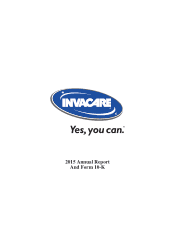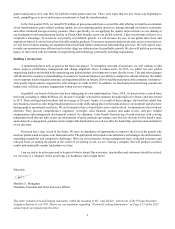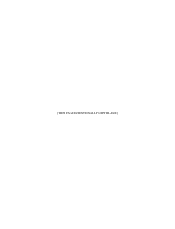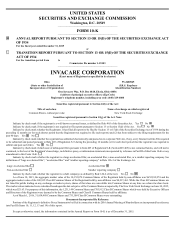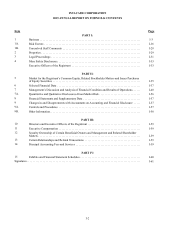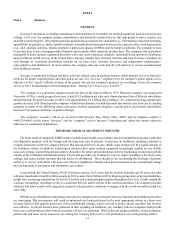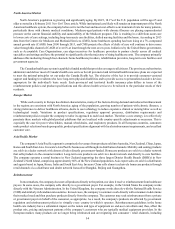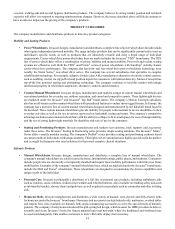Invacare 2015 Annual Report Download - page 10
Download and view the complete annual report
Please find page 10 of the 2015 Invacare annual report below. You can navigate through the pages in the report by either clicking on the pages listed below, or by using the keyword search tool below to find specific information within the annual report.I-4
North America Market
North America's population is growing and significantly aging. By 2025, 18.1% of the U.S. population will be age 65 and
older as noted in a February 2011 New York Times article. While institutional care likely will remain an important part of the North
American healthcare system, the company believes it is not the best and most cost-effective environment of care for many patients,
particularly those with chronic medical conditions. Medicare-aged patients with chronic illnesses are placing unprecedented
pressure on the current financial stability and sustainability of the Medicare program. This is resulting in a shift from acute care
to lower costs of care settings, including long-term acute care facilities, skilled nursing facilities and the home. According to 2013
data from the Centers for Medicare and Medicaid Services (CMS), home healthcare spending has been rising at a 7% compound
annual growth rate (CAGR) from 2000 through 2013, and CMS projects the effects of shifts of care will continue to drive more
value through this channel of CAGR of over 6% at least through the next seven years. Initiatives by the United States government,
such as Accountable Care Organizations, can align incentives for healthcare providers to partner closely across all medical
specialties and settings and have the potential to significantly alter the trajectory of rising healthcare costs. The company primarily
addresses this marketing through four channels: home healthcare providers, rehabilitation providers, long-term care facilities and
government agencies.
The Canadian health care system is a publicly funded model that provides coverage to all citizens. The provinces and territories
administer and deliver most of Canada's health care services but all provincial and territorial health insurance plans are expected
to meet the national principles set out under the Canada Health Act. The objective of the Act is to provide consumer-centered
support and funding to residents who have long-term physical disabilities and to provide access to personalized assistive devices
appropriate for the individual’s basic needs. Each provincial and territorial health insurance plan differs in terms of the
reimbursement policies and product specifications and this allows health services to be tailored to the particular needs of their
residents.
Europe Market
While each country in Europe has distinct characteristics, many of the factors driving demand and reduced reimbursement
in the regions are consistent with North America: aging of the population, growing number of patients with chronic illnesses, a
strong preference to deliver healthcare at home, desire to use technology to reduce expensive clinical or nursing labor as well as
technological trends. Variations in product specifications, regulatory approval processes, distribution requirements and
reimbursement policies require the company to tailor its approach to each local market. Therefore a core strategy is to effectively
penetrate these markets with global product platforms that are localized with country-specific adjustments as necessary. This is
especially the case for power wheelchairs, manual wheelchairs, and respiratory products. In all European countries, customers
make product selections based upon quality, product specification alignment with local reimbursement requirements, and excellent
customer care.
Asia/Pacific Market
The company's Asia/Pacific segment is comprised of revenues from products sold into Australia, New Zealand, China, Japan,
Korea and South East Asia. Invacare's Asia/Pacific businesses sell through six distribution channels. Mobility and seating products
are sold via a dealer network with almost all sales directly government-funded. Homecare products are sold via a dealer network
that sells products to the consumer market. Long-term care products are sold via a dealer network and directly to care facilities.
The company operates a rental business in New Zealand supporting the three largest District Health Boards (DHB’s) in New
Zealand’s North Island, comprising approximately 60% of the New Zealand population. Asia export sales are sold via distributors
and agents based in Japan, Korea, India and South East Asia. Invacare China sells almost exclusively homecare products through
retail channels via a distributor and dealer network focused in Shanghai, Beijing and Guangzhou.
Reimbursement
In most markets, the company does not sell products directly to the patient, nor does it receive reimbursement from healthcare
payors. In some cases, the company sells directly to a government payor. For example, in the United States the company works
directly with the Veterans Administration. In the United Kingdom, the company works directly with the National Health Service
(NHS) and similarly in Scandinavian countries. In most cases, the company’s customers work directly with consumers to determine
their medical need and then purchase products directly from the company. The customer may seek reimbursement from a private
or government payor on behalf of the consumer, as appropriate. As a result, the company's products are affected by government
regulation and reimbursement policies in virtually every country in which it operates. Reimbursement guidelines in the home
health care industry have a substantial impact on the nature and type of equipment an end-user can obtain and, thus, affect the
product mix, pricing and payment patterns of the company’s customers who are typically medical equipment providers. In the
European market, many products are no longer being reimbursed and are migrating into consumer / retail channels, including

